Friday, 9 July 2010: Brussels museums
Written 9 July 2010
As usual, after flying all night and then staying up all day sight-seeing, I slept like a baby and woke up ready for breakfast (albeit a little later than usual this time, at 7:30 rather than 7:00 a.m.). We get the breakfast buffet free with our room, so while David slept blissfully on (also as usual), I packed up Kindle, computer, and water bottle and headed down to the restaurant. Alas, in the restaurant (by night a New York themed steak house), bedlam reigned! A large golden-age bus tour, a major business conference of some sort, and apparently every other guest in the hotel had all shown up for breakfast simultaneously, 20 minutes before me! The buffet was ravaged, every seat was taken, and the conversation and clash of crockery were deafening. I pounced on a table left empty by three business men off to their conference (the hotel's four meeting rooms are called "Yen," "Euro," "Sterling," and "Dollar"), piled my stuff on a chair and their dirty dishes to one side, and set out in search of something to eat. It looks like a pretty good buffet, at least when the swarm of locusts hasn't just hit it). Several kinds of sliced bread; crusty baguettes; croissants, pain au chocolate, and baby apple turnovers; a couple of flavors of American-style muffins; margarine, butter, and nutella; four fruit juices; six kinds of cut fresh fruit (I had watermelon); eight kinds of whole fresh fruit; several dry cereals; three "fatnesses" of milk; all kinds of jams, jellies, dried fruits, and fruit compotes; several flavors of yogurt; four cheeses (I had ricotta salata and brie); smoked salmon with the usual accompaniments (including tiny white pickled onions the size of large peas); several kinds of cold cuts and square slices of sandwich cheese; hot water and tea bags; and chafing dishes of bacon (undercooked), scrambled eggs (overcooked), plump chicken sausages (very good), grilled mushrooms, potato cakes (also very good), and thick pancakes (looking as though they were made in a mold like waffles) with maple syrup.
Plates were on the buffet, and I scavenged silverware and a napkin from the butler's pantry and managed to assemble not a bad breakfast from the wreckage. The ravening hordes mostly cleared out shortly afterward, and I eventually got a waiter's attention, but my attempt at getting a decaf café au lait didn't meet with much success. By the time, he took my order, searched the kitchen for decaf grounds, brewed a ferociously strong pot of of it, and brought it to me (forgetting the "au lait" part), and I had scavenged a larger cup and cut it 50% with cold milk from the buffet, it was pretty tepid and I'd eaten most of my breakfast, but maybe tomorrow. David showed up earlier than usual, in the midst of all this, and he drinks his coffee black, so he enjoyed a freshly brewed hot cup of decaf as soon as he got there.
I didn't even get the computer booted up, let alone work on the blog, then David needed the computer for half an hour to practice his talk for next week, so I'm running behind already!
As an aside, as I sit here at 5:45 p.m. on a Friday afternoon, a grey-haired, bebearded guy in a bright yellow t-shirt, with flags on his hat, is standing on the steps of the Bourse holding forth through a bull-horn. The only thing we can make out on the placards surrounding him is a large map of Israel (but the flags are not Israeli flags). He's yelling in English, but we can make out a few of the words. He seems to be speaking on behalf of the Palestinians.
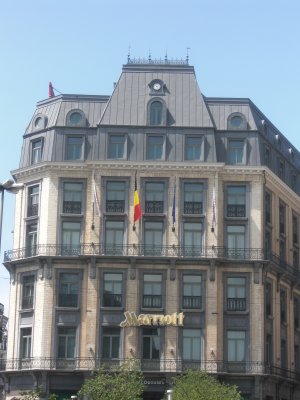 Anyway, once we finally went out, our first stop was a little subterranean museum right next to the Bourse, just below our window. It's an archeological dig about 10 feet below street level and covered with a sort of greenhouse roof, presumably unearthed during construction of the adjacent parking garage. (I am reassured that cities will never surrender to the urge to close in and build on all their open and green spaces, because they need the parking garages.) From its entrance, I got this shot of our hotel. Our window is the one at the top center, right below the clock. I took the liberty of framing the photo to cut off the first floor, which houses a bussling and typically garish McDonalds. Unfortunately, as a sign on the door revealed, the little museum can be visited only on Wednesday afternoon (and at other times by appointment, but only for large groups). Since we came to town on a Thursday and will leave on Sunday morning, that one's out. (We hope to get to another subterranean museum, billed as being under the shopping gallaries we so admired.)
Anyway, once we finally went out, our first stop was a little subterranean museum right next to the Bourse, just below our window. It's an archeological dig about 10 feet below street level and covered with a sort of greenhouse roof, presumably unearthed during construction of the adjacent parking garage. (I am reassured that cities will never surrender to the urge to close in and build on all their open and green spaces, because they need the parking garages.) From its entrance, I got this shot of our hotel. Our window is the one at the top center, right below the clock. I took the liberty of framing the photo to cut off the first floor, which houses a bussling and typically garish McDonalds. Unfortunately, as a sign on the door revealed, the little museum can be visited only on Wednesday afternoon (and at other times by appointment, but only for large groups). Since we came to town on a Thursday and will leave on Sunday morning, that one's out. (We hope to get to another subterranean museum, billed as being under the shopping gallaries we so admired.)
So on to the next, which was the brewing museum in the brewers' guild hall. The price of admission included a glass of light or dark beer (your choice). The museum consisted mainly of a very good film surrounded by old and new brewing equipment, rather sketchily labeled. The film could have gone into more detail about the basics of beer brewing, but it gave a very good overview of the kinds and types of Belgian beer, though it coudn't deal individually with all 400 of them. It covered the differences between top- and bottom-fermented and carbonated and uncarbonated beers; explained how the popular "kriek" is made (roasted fresh sour cherries are added to the wort before fermentation); talked about "saison" (i.e., seasonal) beers, traditionally brewed only in winter, when farmworkers were otherwise idle; "geuze" beers, which are fermented by wild yeast rather than domesticated brewers' yeast (the wort is poured into wide, flat, open-topped tanks, and outdoor air is blown over it to bring in the requisite microorganisms); light, dark, and white (i.e., wheat-based) beers (the last of which are traditionally served unfiltered and cloudy); Trappist and "other" monastary beer (Trappist beer is entirely brewed by actual Trappist monks, in their monastaries, whereas other monastary beer is made in factorys, only some of which are associated with real monastaries, according to a particular monastary style); lagered beers, like Pils; etc., etc. The film claimed there are only six Trappist monastaries in the world, five in Belgium and one in the Netherlands. David is convinced there are Trappists in Georgia, but maybe they don't make beer.
An even better "side" film covered the process of malting barley, which I had always been curious about. It went into all the requisite detail.
In the tasting room, David chose light beer, so I took dark so that he could taste that, too. Predictably, I didn't like either one, though the darker one was a little sweeter and less bitter, so if I had to drink beer . . . David preferred the light at the time, but within an hour said that it hadn't agreed with him. He always has trouble with India pale ales, which give him headaches, so maybe this light beer had some of whatever they contain. The pouring process was interesting. The barkeep/curator drew the beer into the glass until it overflowed slightly, used a little metal straight-edge to scrape off the large bubbles protruding above the rim of the glass, leaving just the small wet (tastier?) bubbles, then dipped the whole thing almost to the rim in a tank of water (to rinse off all the beer and bubbles running down the outside), dried the foot on a towel, and set it on the bar!
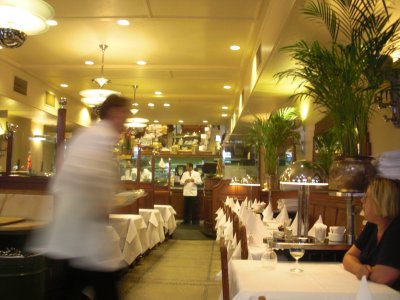
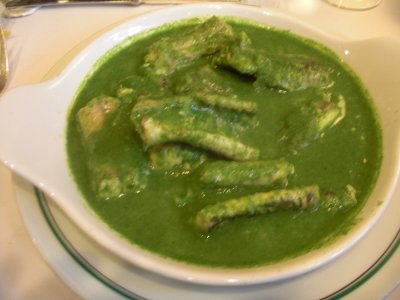 By then, it was lunchtime, and we succumbed to the Brasserie Flo, agreeing to order only a main course, so as to conserve appetite for dinner. I was delighted to get this wonderful shot of the interior that, just like the photos in our book on the subject, shows our waiter blurred with motion—unless you engage them in conversation about the food, the waiters in a Brasserie Flo never hold still long enough for a photo! I had to go for the eel in green sauce (anguille au vert). I noticed on the menu that it was listed in the singular (not "eels" in green sauce), and sure enough, my portion seemed to consist of exactly one entire eel, minus the head, cut into three-inch sections, from the ribcage back to the thin, pointy little tail. It was doused with a large quantity of definitely green sauce, a purée of lots of green onions, parsley, and other green herbs. Before it arrived, the waiter brought me a plate for the bones and a large wash-and-dry for my fingers, so I thought I might have to tackle it with my hands, but as it turned out I was able to hold the pieces down with my fork and scrape the meat off the bones (all of which held neatly together, leaving no small bones in the meat) with my fish knife.
By then, it was lunchtime, and we succumbed to the Brasserie Flo, agreeing to order only a main course, so as to conserve appetite for dinner. I was delighted to get this wonderful shot of the interior that, just like the photos in our book on the subject, shows our waiter blurred with motion—unless you engage them in conversation about the food, the waiters in a Brasserie Flo never hold still long enough for a photo! I had to go for the eel in green sauce (anguille au vert). I noticed on the menu that it was listed in the singular (not "eels" in green sauce), and sure enough, my portion seemed to consist of exactly one entire eel, minus the head, cut into three-inch sections, from the ribcage back to the thin, pointy little tail. It was doused with a large quantity of definitely green sauce, a purée of lots of green onions, parsley, and other green herbs. Before it arrived, the waiter brought me a plate for the bones and a large wash-and-dry for my fingers, so I thought I might have to tackle it with my hands, but as it turned out I was able to hold the pieces down with my fork and scrape the meat off the bones (all of which held neatly together, leaving no small bones in the meat) with my fish knife.
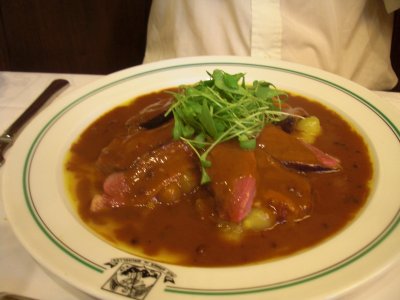 David got the rare grilled duck breast, which was sliced, laid over a large pile of braised pearl onions (each the size of a marble), and doused with a delicious dark red (cherry?) sweet-and-salty sauce with peppercorns in it. The green sauce was really good, but the red sauce was really good, especially with the duck and the little onions. It came with a dish of the usual skinny fries they serve around here, but mine came with special jumbo fries ("des grosses frites") intended to be dumped right into the green sauce. It struck me as we feasted that, in the course of the evolution of cuisine, very probably the gentry up in the castle dined on fat poultry grilled in a sauce sweet with fruit and spicy with imported pepper, while the peasants down by the river ate trash fish in weed sauce.
David got the rare grilled duck breast, which was sliced, laid over a large pile of braised pearl onions (each the size of a marble), and doused with a delicious dark red (cherry?) sweet-and-salty sauce with peppercorns in it. The green sauce was really good, but the red sauce was really good, especially with the duck and the little onions. It came with a dish of the usual skinny fries they serve around here, but mine came with special jumbo fries ("des grosses frites") intended to be dumped right into the green sauce. It struck me as we feasted that, in the course of the evolution of cuisine, very probably the gentry up in the castle dined on fat poultry grilled in a sauce sweet with fruit and spicy with imported pepper, while the peasants down by the river ate trash fish in weed sauce.
The decor was definitely art deco, though not as extreme a case as some we've seen, though, as usual, the theme continued right to the hat racks and coat hooks.
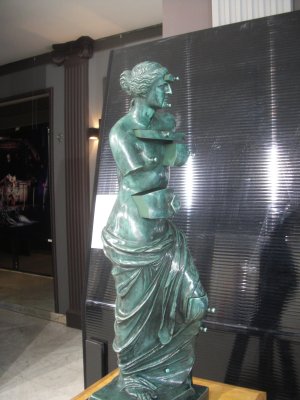 Next on the agenda was a temporary Dali exhibition in one of the buildings off the Grande Place. It featured, in particular, a long series of pen-and-ink drawings of stories from Greek mythology (I especially liked Leda and the Swan and Icarus, not suitable for display here); a set of three-foot original lithographs of the kings, queens, and jacks Dali designed for a deck of cards; a series of drawings of horses (come colored and some not); and another series of pen-and-ink portraits of famous people. The portraits managed to be both very Dali-esque and amazingly true to life. In addition to these series, we saw a number of individual works, including a large and amazing surreal landscape with a body of water in which several swans were quite realistically reflected, except that, in the reflections, they were elephants (what an eye the man had!). I was able to get a shot of one of my all-time Dali favorites, the Venus de Milo as a chest of drawers (it was present both in bronze and in a couple of other media, like a drawing and a miniature). Another intriguing piece was a painting called "Lincoln in Dalivision," consisting of a collage of blocks of color and little drawings of heads and geometric shapes, all grouped around a drawing of a central nude. You had to back way off (like 30 m) to see that it was also a portrait of Abraham Lincoln. No melted clocks at all, but I liked this side of Dali better than the melted clocks anyway.
Next on the agenda was a temporary Dali exhibition in one of the buildings off the Grande Place. It featured, in particular, a long series of pen-and-ink drawings of stories from Greek mythology (I especially liked Leda and the Swan and Icarus, not suitable for display here); a set of three-foot original lithographs of the kings, queens, and jacks Dali designed for a deck of cards; a series of drawings of horses (come colored and some not); and another series of pen-and-ink portraits of famous people. The portraits managed to be both very Dali-esque and amazingly true to life. In addition to these series, we saw a number of individual works, including a large and amazing surreal landscape with a body of water in which several swans were quite realistically reflected, except that, in the reflections, they were elephants (what an eye the man had!). I was able to get a shot of one of my all-time Dali favorites, the Venus de Milo as a chest of drawers (it was present both in bronze and in a couple of other media, like a drawing and a miniature). Another intriguing piece was a painting called "Lincoln in Dalivision," consisting of a collage of blocks of color and little drawings of heads and geometric shapes, all grouped around a drawing of a central nude. You had to back way off (like 30 m) to see that it was also a portrait of Abraham Lincoln. No melted clocks at all, but I liked this side of Dali better than the melted clocks anyway.
We passed up the exhibition in the city hall ("The Age of Symbolism in Latvia") and walked home to rest our feet. On the way we watched a hilarious phenomenon, repeated several times—as each group tour emerged from a little side street into the Grande Place, the first few in the group would catch sight of the town hall, say "Wow!," stop dead, and raise their cameras to take a photo. Those behind would collide with them, look up, say "Wow!," and raise their cameras in turn, as the leaders, knocked off balance, stumbled forward out of their way, those behind collided with the second wave, etc. A sort of standing-wave traffic jam of collisions and snapping shutters. Further along, we passed a wonderful painting in sidewalk chalk, maybe six by eight feet (the artist had just been beginning it the previous day) protraying the Mona Lisa packaged for shipping. A rip in the plastic sheeting lets her peek out. We also passed a trio of plump sunburned lady tourists drinking cokes with lemon slices and sharing a big plate of nachos outside an Irish pub. They're not kidding when they say Brussels is an international city! Back at the hotel room, I found that a seventh tower crane had joined our field of view.
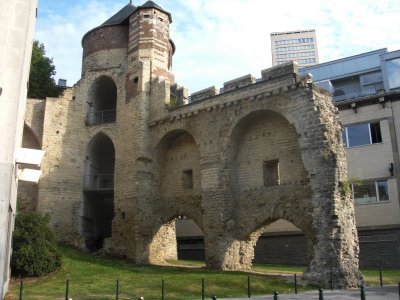
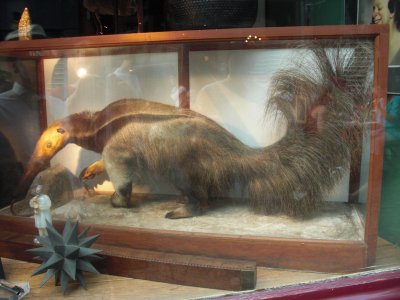 Our dinner reservations for the evening were at "La Clef des Champs" (the key to the fields), in the Rue Rollebeek, which turned out to be a short pedestrian way thickly lined with restaurants. On the way there, we chanced on this section of the old city wall. The arches had railings, as though it were possible to climb it, but we couldn't see an entrance. Then, right across the street from the restaurant, we found a shop window displaying this astonishing stuffed anteater, fully five feet long! An aardvark, maybe?
Our dinner reservations for the evening were at "La Clef des Champs" (the key to the fields), in the Rue Rollebeek, which turned out to be a short pedestrian way thickly lined with restaurants. On the way there, we chanced on this section of the old city wall. The arches had railings, as though it were possible to climb it, but we couldn't see an entrance. Then, right across the street from the restaurant, we found a shop window displaying this astonishing stuffed anteater, fully five feet long! An aardvark, maybe?
As often happens, we were the only ones to choose to sit inside the restaurant—everyone else, for some reason, preferred to sit out on the cobblestones, in the blazing sun (it's nearly as hot as Tallahassee this week). One of the four members of the kitchen staff didn't show up, so they were working with a stand-in, and as a result, service was slowed considerably all evening. We had long waits between courses, but we were in no hurry (glad it didn't happen the night before, when we'd have been asleep with our foreheads on the tablecloth).
The amuse-bouche was a little bowl of black and green olives and round garlic toasts accompanied by a delicious sweet stewed mixture of onions and bell peppers, almost a jam. Wonderful.
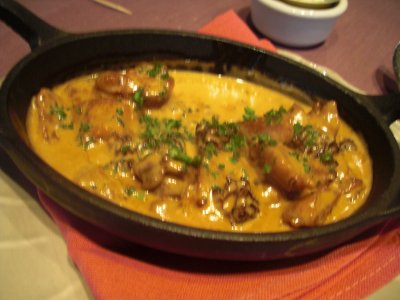
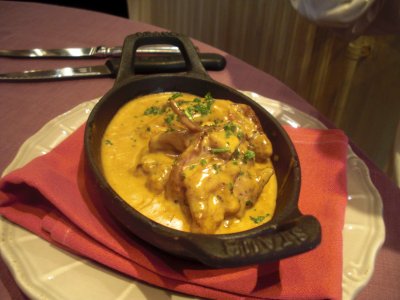 We chose the "city" menu (45 euros, as opposed to the slightly less expensive "country" menu). I started with veal sweetbreads in a rosy-colored cream sauce, with morel mushrooms. Yummy! I sopped up every drop of the sauce with bits of bread. David ordered quail in a similar sauce, but with truffels as well as morels. Also yummy. The quail was billed as "boned," but turned out to have all the bones in its extremities intact. The waiter brought a fingerbowl with the quail, so fingers were clearly allowed, but I was still astonished that David was willing to use his—a compliment to the chef indeed!
We chose the "city" menu (45 euros, as opposed to the slightly less expensive "country" menu). I started with veal sweetbreads in a rosy-colored cream sauce, with morel mushrooms. Yummy! I sopped up every drop of the sauce with bits of bread. David ordered quail in a similar sauce, but with truffels as well as morels. Also yummy. The quail was billed as "boned," but turned out to have all the bones in its extremities intact. The waiter brought a fingerbowl with the quail, so fingers were clearly allowed, but I was still astonished that David was willing to use his—a compliment to the chef indeed!
Next came a little palate cleanser (billed as a "trait d'union," a hyphen, on the menu)—a tiny bowl of smooth, sweet gazpacho garnished with parsley leaves. Tasty. Gazpachos have been all the rage in French restaurants for the last couple of years, but this was our first one of the trip.
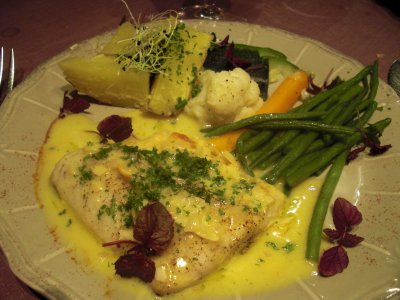
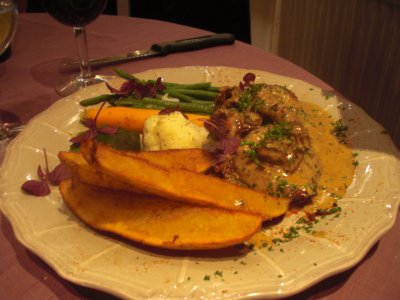 For the main course, I had "sandre aux écailles d'amandes" (zander, i.e. Lucioperca lucioperca with almond scales) and a delicious "beurre blanc" sauce, and David had rare grilled pigeon with yet another rosy cream sauce. Both were garnished with a selection of vegetables (more like an English dinner plate than a French one) and potatoes, David's fried and mine boiled and sprinkled with leek sprouts, and both plates were in turn sprinkled with sprigs of opal basil. Both excellent! Though David said that next time he probably wouldn't order two birds in a row—not enough variety
For the main course, I had "sandre aux écailles d'amandes" (zander, i.e. Lucioperca lucioperca with almond scales) and a delicious "beurre blanc" sauce, and David had rare grilled pigeon with yet another rosy cream sauce. Both were garnished with a selection of vegetables (more like an English dinner plate than a French one) and potatoes, David's fried and mine boiled and sprinkled with leek sprouts, and both plates were in turn sprinkled with sprigs of opal basil. Both excellent! Though David said that next time he probably wouldn't order two birds in a row—not enough variety
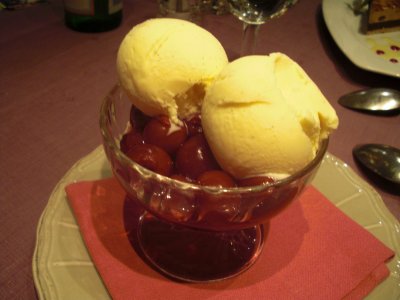
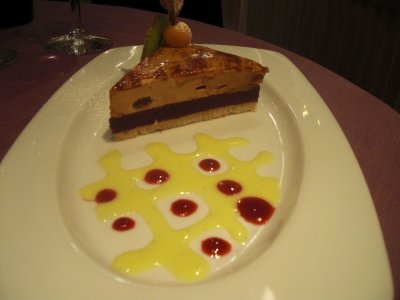 For dessert, I chose "cup of hot and cold cherries with kirsch," a bowl of hot stewed cherries with kirsch (cherry brandy) poured over them, topped with two balls of delicious vanilla ice cream. David order "craquelin" (i.e., crispy thing) of hazelnuts mousse and chocolate, which turned out to be a multilayered concoction in which a crisp cooky was topped with a layer of dense chocolate, in turn covered with a layer of hazelnut mousse (with whole hazelnuts embedded in it), and topped with a thin, shiny glaze and garnished with a ground cherry (i.e., a Physalis berry). Again, both excellent.
For dessert, I chose "cup of hot and cold cherries with kirsch," a bowl of hot stewed cherries with kirsch (cherry brandy) poured over them, topped with two balls of delicious vanilla ice cream. David order "craquelin" (i.e., crispy thing) of hazelnuts mousse and chocolate, which turned out to be a multilayered concoction in which a crisp cooky was topped with a layer of dense chocolate, in turn covered with a layer of hazelnut mousse (with whole hazelnuts embedded in it), and topped with a thin, shiny glaze and garnished with a ground cherry (i.e., a Physalis berry). Again, both excellent.
By the time we left, it was after 10:30 p.m. and finally getting dark. We strolled homeward by a different route, just to see other sights, and decided, at the end to detour through the Grande Place again, just to see the buildings illuminated. They were lovely, so we stood around for a while admiring them. We had noticed earlier that groups of young people were in the habit of sitting, right on the bare paving stones, all over the place (fortunately closed to vehicular traffic), picnicking at lunch time (often with paper cones of french fries topped with a splodge of mayo and a diminutive 2" plastic fork), but here they still were, still sitting on the pavement (well, not necessarily the same ones who had been there at noon), and mostly facing the town hall. (In several places, I saw little glowing objects passed from hand to hand in the dark and was about to tsk-tsk until I realized that they were cell-phone screens!) Then, at the stroke of 11 p.m., while we still stood there, all the lights went out, and a lovely son-et-lumière started up. The lumière part was mainly changing colors and a few abstract patterns, as the façade of the town hall is all stone filigree and doesn't really lend itself to projection of images. The sound was all instrumental music (excellent accoustics), includeing a few short passages of Jacques Brel melodies, some classical, some modern. It lasted about 20 minutes, at which point, we continued on our way to the hotel.
previous entry
List of Entries
next entry
 Anyway, once we finally went out, our first stop was a little subterranean museum right next to the Bourse, just below our window. It's an archeological dig about 10 feet below street level and covered with a sort of greenhouse roof, presumably unearthed during construction of the adjacent parking garage. (I am reassured that cities will never surrender to the urge to close in and build on all their open and green spaces, because they need the parking garages.) From its entrance, I got this shot of our hotel. Our window is the one at the top center, right below the clock. I took the liberty of framing the photo to cut off the first floor, which houses a bussling and typically garish McDonalds. Unfortunately, as a sign on the door revealed, the little museum can be visited only on Wednesday afternoon (and at other times by appointment, but only for large groups). Since we came to town on a Thursday and will leave on Sunday morning, that one's out. (We hope to get to another subterranean museum, billed as being under the shopping gallaries we so admired.)
Anyway, once we finally went out, our first stop was a little subterranean museum right next to the Bourse, just below our window. It's an archeological dig about 10 feet below street level and covered with a sort of greenhouse roof, presumably unearthed during construction of the adjacent parking garage. (I am reassured that cities will never surrender to the urge to close in and build on all their open and green spaces, because they need the parking garages.) From its entrance, I got this shot of our hotel. Our window is the one at the top center, right below the clock. I took the liberty of framing the photo to cut off the first floor, which houses a bussling and typically garish McDonalds. Unfortunately, as a sign on the door revealed, the little museum can be visited only on Wednesday afternoon (and at other times by appointment, but only for large groups). Since we came to town on a Thursday and will leave on Sunday morning, that one's out. (We hope to get to another subterranean museum, billed as being under the shopping gallaries we so admired.)
 By then, it was lunchtime, and we succumbed to the Brasserie Flo, agreeing to order only a main course, so as to conserve appetite for dinner. I was delighted to get this wonderful shot of the interior that, just like the photos in our book on the subject, shows our waiter blurred with motion—unless you engage them in conversation about the food, the waiters in a Brasserie Flo never hold still long enough for a photo! I had to go for the eel in green sauce (anguille au vert). I noticed on the menu that it was listed in the singular (not "eels" in green sauce), and sure enough, my portion seemed to consist of exactly one entire eel, minus the head, cut into three-inch sections, from the ribcage back to the thin, pointy little tail. It was doused with a large quantity of definitely green sauce, a purée of lots of green onions, parsley, and other green herbs. Before it arrived, the waiter brought me a plate for the bones and a large wash-and-dry for my fingers, so I thought I might have to tackle it with my hands, but as it turned out I was able to hold the pieces down with my fork and scrape the meat off the bones (all of which held neatly together, leaving no small bones in the meat) with my fish knife.
By then, it was lunchtime, and we succumbed to the Brasserie Flo, agreeing to order only a main course, so as to conserve appetite for dinner. I was delighted to get this wonderful shot of the interior that, just like the photos in our book on the subject, shows our waiter blurred with motion—unless you engage them in conversation about the food, the waiters in a Brasserie Flo never hold still long enough for a photo! I had to go for the eel in green sauce (anguille au vert). I noticed on the menu that it was listed in the singular (not "eels" in green sauce), and sure enough, my portion seemed to consist of exactly one entire eel, minus the head, cut into three-inch sections, from the ribcage back to the thin, pointy little tail. It was doused with a large quantity of definitely green sauce, a purée of lots of green onions, parsley, and other green herbs. Before it arrived, the waiter brought me a plate for the bones and a large wash-and-dry for my fingers, so I thought I might have to tackle it with my hands, but as it turned out I was able to hold the pieces down with my fork and scrape the meat off the bones (all of which held neatly together, leaving no small bones in the meat) with my fish knife. David got the rare grilled duck breast, which was sliced, laid over a large pile of braised pearl onions (each the size of a marble), and doused with a delicious dark red (cherry?) sweet-and-salty sauce with peppercorns in it. The green sauce was really good, but the red sauce was really good, especially with the duck and the little onions. It came with a dish of the usual skinny fries they serve around here, but mine came with special jumbo fries ("des grosses frites") intended to be dumped right into the green sauce. It struck me as we feasted that, in the course of the evolution of cuisine, very probably the gentry up in the castle dined on fat poultry grilled in a sauce sweet with fruit and spicy with imported pepper, while the peasants down by the river ate trash fish in weed sauce.
David got the rare grilled duck breast, which was sliced, laid over a large pile of braised pearl onions (each the size of a marble), and doused with a delicious dark red (cherry?) sweet-and-salty sauce with peppercorns in it. The green sauce was really good, but the red sauce was really good, especially with the duck and the little onions. It came with a dish of the usual skinny fries they serve around here, but mine came with special jumbo fries ("des grosses frites") intended to be dumped right into the green sauce. It struck me as we feasted that, in the course of the evolution of cuisine, very probably the gentry up in the castle dined on fat poultry grilled in a sauce sweet with fruit and spicy with imported pepper, while the peasants down by the river ate trash fish in weed sauce. Next on the agenda was a temporary Dali exhibition in one of the buildings off the Grande Place. It featured, in particular, a long series of pen-and-ink drawings of stories from Greek mythology (I especially liked Leda and the Swan and Icarus, not suitable for display here); a set of three-foot original lithographs of the kings, queens, and jacks Dali designed for a deck of cards; a series of drawings of horses (come colored and some not); and another series of pen-and-ink portraits of famous people. The portraits managed to be both very Dali-esque and amazingly true to life. In addition to these series, we saw a number of individual works, including a large and amazing surreal landscape with a body of water in which several swans were quite realistically reflected, except that, in the reflections, they were elephants (what an eye the man had!). I was able to get a shot of one of my all-time Dali favorites, the Venus de Milo as a chest of drawers (it was present both in bronze and in a couple of other media, like a drawing and a miniature). Another intriguing piece was a painting called "Lincoln in Dalivision," consisting of a collage of blocks of color and little drawings of heads and geometric shapes, all grouped around a drawing of a central nude. You had to back way off (like 30 m) to see that it was also a portrait of Abraham Lincoln. No melted clocks at all, but I liked this side of Dali better than the melted clocks anyway.
Next on the agenda was a temporary Dali exhibition in one of the buildings off the Grande Place. It featured, in particular, a long series of pen-and-ink drawings of stories from Greek mythology (I especially liked Leda and the Swan and Icarus, not suitable for display here); a set of three-foot original lithographs of the kings, queens, and jacks Dali designed for a deck of cards; a series of drawings of horses (come colored and some not); and another series of pen-and-ink portraits of famous people. The portraits managed to be both very Dali-esque and amazingly true to life. In addition to these series, we saw a number of individual works, including a large and amazing surreal landscape with a body of water in which several swans were quite realistically reflected, except that, in the reflections, they were elephants (what an eye the man had!). I was able to get a shot of one of my all-time Dali favorites, the Venus de Milo as a chest of drawers (it was present both in bronze and in a couple of other media, like a drawing and a miniature). Another intriguing piece was a painting called "Lincoln in Dalivision," consisting of a collage of blocks of color and little drawings of heads and geometric shapes, all grouped around a drawing of a central nude. You had to back way off (like 30 m) to see that it was also a portrait of Abraham Lincoln. No melted clocks at all, but I liked this side of Dali better than the melted clocks anyway.
 Our dinner reservations for the evening were at "La Clef des Champs" (the key to the fields), in the Rue Rollebeek, which turned out to be a short pedestrian way thickly lined with restaurants. On the way there, we chanced on this section of the old city wall. The arches had railings, as though it were possible to climb it, but we couldn't see an entrance. Then, right across the street from the restaurant, we found a shop window displaying this astonishing stuffed anteater, fully five feet long! An aardvark, maybe?
Our dinner reservations for the evening were at "La Clef des Champs" (the key to the fields), in the Rue Rollebeek, which turned out to be a short pedestrian way thickly lined with restaurants. On the way there, we chanced on this section of the old city wall. The arches had railings, as though it were possible to climb it, but we couldn't see an entrance. Then, right across the street from the restaurant, we found a shop window displaying this astonishing stuffed anteater, fully five feet long! An aardvark, maybe?
 We chose the "city" menu (45 euros, as opposed to the slightly less expensive "country" menu). I started with veal sweetbreads in a rosy-colored cream sauce, with morel mushrooms. Yummy! I sopped up every drop of the sauce with bits of bread. David ordered quail in a similar sauce, but with truffels as well as morels. Also yummy. The quail was billed as "boned," but turned out to have all the bones in its extremities intact. The waiter brought a fingerbowl with the quail, so fingers were clearly allowed, but I was still astonished that David was willing to use his—a compliment to the chef indeed!
We chose the "city" menu (45 euros, as opposed to the slightly less expensive "country" menu). I started with veal sweetbreads in a rosy-colored cream sauce, with morel mushrooms. Yummy! I sopped up every drop of the sauce with bits of bread. David ordered quail in a similar sauce, but with truffels as well as morels. Also yummy. The quail was billed as "boned," but turned out to have all the bones in its extremities intact. The waiter brought a fingerbowl with the quail, so fingers were clearly allowed, but I was still astonished that David was willing to use his—a compliment to the chef indeed!
 For the main course, I had "sandre aux écailles d'amandes" (zander, i.e. Lucioperca lucioperca with almond scales) and a delicious "beurre blanc" sauce, and David had rare grilled pigeon with yet another rosy cream sauce. Both were garnished with a selection of vegetables (more like an English dinner plate than a French one) and potatoes, David's fried and mine boiled and sprinkled with leek sprouts, and both plates were in turn sprinkled with sprigs of opal basil. Both excellent! Though David said that next time he probably wouldn't order two birds in a row—not enough variety
For the main course, I had "sandre aux écailles d'amandes" (zander, i.e. Lucioperca lucioperca with almond scales) and a delicious "beurre blanc" sauce, and David had rare grilled pigeon with yet another rosy cream sauce. Both were garnished with a selection of vegetables (more like an English dinner plate than a French one) and potatoes, David's fried and mine boiled and sprinkled with leek sprouts, and both plates were in turn sprinkled with sprigs of opal basil. Both excellent! Though David said that next time he probably wouldn't order two birds in a row—not enough variety
 For dessert, I chose "cup of hot and cold cherries with kirsch," a bowl of hot stewed cherries with kirsch (cherry brandy) poured over them, topped with two balls of delicious vanilla ice cream. David order "craquelin" (i.e., crispy thing) of hazelnuts mousse and chocolate, which turned out to be a multilayered concoction in which a crisp cooky was topped with a layer of dense chocolate, in turn covered with a layer of hazelnut mousse (with whole hazelnuts embedded in it), and topped with a thin, shiny glaze and garnished with a ground cherry (i.e., a Physalis berry). Again, both excellent.
For dessert, I chose "cup of hot and cold cherries with kirsch," a bowl of hot stewed cherries with kirsch (cherry brandy) poured over them, topped with two balls of delicious vanilla ice cream. David order "craquelin" (i.e., crispy thing) of hazelnuts mousse and chocolate, which turned out to be a multilayered concoction in which a crisp cooky was topped with a layer of dense chocolate, in turn covered with a layer of hazelnut mousse (with whole hazelnuts embedded in it), and topped with a thin, shiny glaze and garnished with a ground cherry (i.e., a Physalis berry). Again, both excellent.